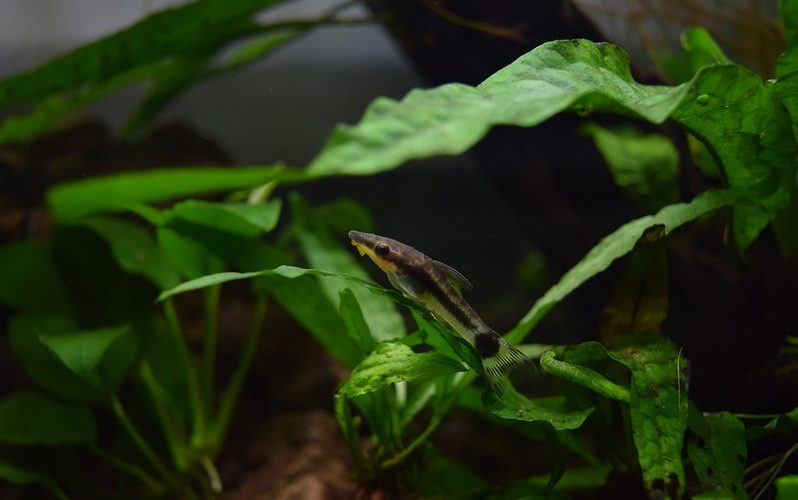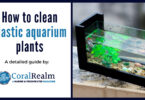Last Updated on November 19, 2022 by Matt
Java fern is a classic freshwater aquarium plant which can be readily found online or in most pet stores. It is a staple in most aquariums, from large high tech tanks to basic beginner starter tanks. It’s easy to see why it has become so popular with so many; pairing fantastic looks with ease of care makes for a winning combination.
Java fern can be kept with a wide variety of fish and invertebrate species, and can be grown successfully in a wide range of tank conditions. This adaptability and hardiness has made java fern one of the most popular freshwater plants available for fish tanks.
In this java fern care guide we will do our best to provide you with full and complete information on how to keep and care for this amazing species.
| Java Fern Quick Info | |
| Care Level | Easy |
| Temperature Range | 68°F – 82°F (20°C – 27.8°C) |
| pH | 6 – 7.5 |
| Placement | Background, Middle |
| Lighting | Low – Moderate |
| Growth Rate | Slow – Moderate |
| Maximum Size | 13.5 inches |
IN THIS ARTICLE
Java Fern Info
Java fern has the scientific name Microsorum pteropus, and is often sold under this name rather than its common name. It was formerly classified as Leptochilus pteropus, so if you see a plant being sold under this name don’t worry it’s still java fern! Both Microsorum and Leptochilus genera are members of the Polypodiaceae family.
Named after the island of Java found in Indonesia in South East Asia, it isn’t limited in its range to this small island. It can be found naturally throughout Indonesia, Malaysia, Thailand, and parts of bordering China and India. This large range can be attributed to the hardiness of the species and that it can grow just as well both fully submerged and partially submerged.
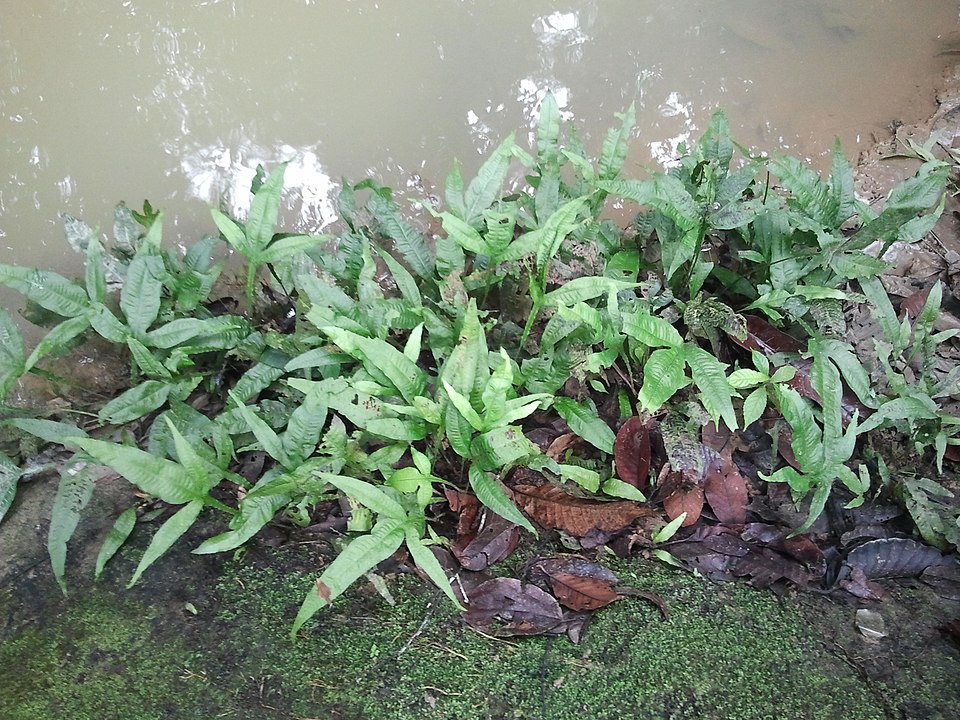
Java fern growing on a riverbank in the wild. Credit: Fhurzan, WikiCommons, CC BY-SA 3.0
Similarly to java moss, java fern doesn’t possess true roots. Instead it has rhizomes which anchor it to a given substrate. The main function of rhizomes is as the attachment and anchor point, although they do also aid in nutrient uptake. The rhizomes are actually the stem of the plant, and small hair-like roots extend out from these structures to further anchor the plant. However the main nutrient uptake takes place through the leaves. This makes java fern a column feeder, drawing nutrients directly from the water column.
Being one of the most popular freshwater plants, java fern has been bred quite extensively and so there are quite a few varieties out there. The most popular are the windelov, needle leaf, trident, and narrow leaf. These varieties all have their slight differences but they are all the same species Microsorum pteropus.
Java Fern Appearance and Varieties
Java fern doesn’t have true roots, instead possessing rhizomes which attach it to the substrate. Large bright green leaves grow directly from the attachment point rather than connected by a central stem as in most terrestrial plants. The rhizomes are in fact the “stem”, with the leaves growing out of these, and small hair like “roots” aiding further in attachment. The adult plant reaches around 13.5 inches in height and 8 inches across if given enough room to grow.
Being able to grow into a large plant gives it the ability to be utilized in the bottom to middle levels of large tanks. In small tanks it can easily be trimmed to the size that is required.
Java fern is found naturally attached to rocks, driftwood, and larger plants and trees. The rhizomes are responsible for attaching the plant to the substrate; they aren’t true roots and aren’t meant to be buried. This is a common mistake in keeping this species. If the rhizomes are buried the plant will have major health issues. As such it is most commonly placed on driftwood, rocks, and other decorations in the aquarium. We will go into more detail about how to attach the rhizomes to substratum later in the article but the easiest way is to use fishing line.
Depending on the variety of Java fern the leaves can be thin, thick, or branching. No matter the variety though, the leaves are the showpiece of Java fern. Growing directly from the base, the leaves are large, quite leathery, and have a beautiful green coloration. In general, in higher light intensity the coloration will be a darker green, and vice versa.
Windelov: The windelov is a stunning Microsorum pteropus variety. The java fern windelov has leaves which branch into three thin leaves at the tips. Branching into three creates the illusion that the plant is a lot more “full” and bushy than it actually is.
Needle leaf: The leaves of this variety are very thin and needle-like, hence the name. Java fern needle leaf is also a much smaller plant than normal, growing to around 6 inches tall rather than the usual 13.
Trident: A highly sought after variant, the java fern trident has multipartite leaves with as many five lobes. However the most common are the tripartite leaves, which is where the common name trident stems from.
Narrow leaf: The leaves of the narrow leaf variety are much narrower than the original plant, as you can imagine! The leaves also grow straighter than normal, giving a more straight-backed adult plant. Leaves of the narrow leaf aren’t as thin and narrow as those of the needle leaf however.
Benefits of Microsorum pteropus
There are a multitude of benefits in keeping live plants in an aquarium, and it is no different with any of the varieties of Java fern. As you probably already know, fish breathe by drawing oxygen from the water as it passes over their gills. Having a well oxygenated tank is very important for your fish’s health. As plants photosynthesize they use carbon dioxide and release oxygen. Therefore having java fern in your tank increases the oxygenation and makes for healthier, more lively fish. Pairing live plants with an aquarium filter which provides good circulation makes for a healthy tank. Without live plants the only way of oxygenating your tank is through circulation and agitation provided by filters or aquarium wave makers.
Having live aquarium plants also makes fish feel more comfortable, as the tank feels more like their natural habitat. Bottom-dwelling fish species such as plecos, clown loaches, and kuhli loaches love to have live plants to explore and the foliage above them makes them more comfortable to show their often unique and amazing behaviors.
How to Plant Java Fern
As we have already said, java fern doesn’t possess true roots. Instead it has rhizomes which anchor it. Unlike roots, rhizomes aren’t meant to be buried in a substrate like sand or mud. They instead grow to wrap around rocks, roots, and other substratum to anchor the plant. While mainly functioning to anchor Microsorum pteropus, they also aid in nutrient uptake.
If you plant the rhizomes like regular roots the health of the plant will slowly deteriorates, and the growth rate slows drastically. If kept like this, it will eventually die.
So how are you meant to attach the rhizomes? There are a couple different ways you can do this. First choose your substratum carefully. The best to use are driftwood, rocks, or other aquarium decorations. Decide where you are going to have the base in the tank, and then decide where you want the java fern attached. Then it’s time to attach the java fern plant. You can use superglue by carefully putting a spot of glue over the rhizome onto your chosen substratum. Only use a small amount of glue, and don’t completely cover all of the rhizomes. Use a spot of glue in each one and wait until it dries. Then return it to the tank and the rhizomes will continue to grow into the object.
The second way of securing the rhizomes to your chosen substratum is to use fishing line. While you can use string, this will rot and start to release toxic chemicals into the water. Simply tie the line around the object securing the rhizomes. After around 2-3 weeks the rhizomes will have grown and integrated themselves fully to the object. You can rove the fishing line at this time, but it is much easier to leave it in place as you can easily damage the rhizomes. For this reason it’s best to use a neutral color of fishing line, or one which matches the color of the object you will be attaching it to.
Java fern does best in the tank when it is places at the back or middle of the tank. As it grows up to 13.5 inches in height, it will most likely be seen if you have a regular aquarium setup. If you have a large aquarium however it could also do well to be placed in the foreground, but we suggest at the edge of the tank so it doesn’t dominate. As it needs lower lighting, it does best placed at the base or middle of the tank, not at the top as it will be too close to the light.
Java Fern Care
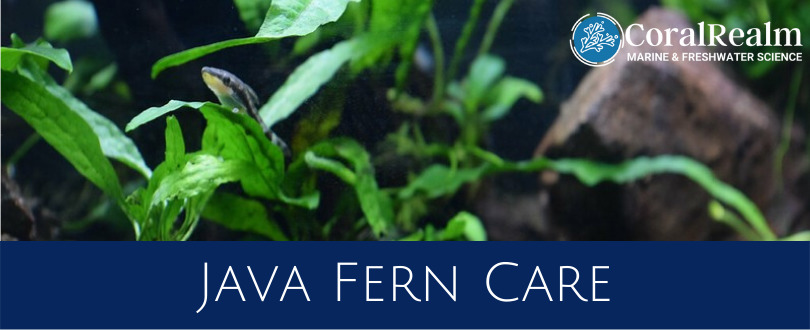
Microsorum pteropus tank requirements
Java fern is found naturally in the tropical and subtropical rainforests of South-East Asia, namely Thailand and Malaysia. It is often found growing near or in flowing rivers, either fully or partially submerged. Interestingly it doesn’t have to be submerged at all; in the humid conditions of the rainforests it will grow on the forest floor as well. As such java fern can be grown fully or partially submerged in an aquarium environment. Warm, slightly acidic, low light conditions best emulate the natural environment. The closer you can get to the natural environment, the higher chance your fern will thrive in your aquarium.
The ideal temperature range is between 68°F and 82°F (20°C and 27.8°C). This is within the usual temperature range of the average tropical aquarium, so you should have no problem with keeping the temperature stable within this range. An aquarium heater and thermometer should be used to maintain this temperature. Not only is it important for your Microsorum pteropus plants, but your fish and invertebrates too.
A pH range of 6-7.5 should be maintained. Ideally the pH will be kept under 7 to emulate the slightly acidic environment of the SE Asian rainforests. The general water hardness should be between 3 and 8 dGH.
Java fern prefers low to medium light conditions. They grow naturally under the forest canopy, which blocks the majority of sunlight from reaching the forest floor. As such they have evolved to require these muted light conditions. LED lights with an output of 5000-7500K are ideal, as are subdued fluorescent lights. Strong lighting will burn the plant and cause serious issues with wilting and browning leaves. If your lighting is too strong for java fern to thrive, having floating aquarium plants can help to shade them sufficiently.
As Microsorum pteropus is small plant which doesn’t grow to a huge size, it can be kept in small aquariums from 10 gallons. While it can be kept in smaller nano aquariums of 5 gallons, it isn’t recommended as it will most likely be too close to the light for comfort, and also may take too much space in the small tank. However a smaller variety such as the java fern needle leaf can work as it only grows to 6 inches in height.
Java fern doesn’t require the use of a CO2 regulator or plant fertilizer. The CO2 which is introduced by the fish and invertebrates in the tank, as well as that via agitation from the filter or aquarium wave maker should be ample to provide what it needs. The nutrients found in the water column should be fine to provide for the plant, but if it needs a boost always use liquid fertilizer as java fern absorbs most of its nutrients via its leaves.
Perhaps the most important thing to be wary of is how to properly grow and attach java fern in the tank. Read our how to plant java fern section for full information. In short though, as java fern have rhizomes rather than true roots, you should attach it to rock, driftwood, or other substrate, not bury the rhizomes in soil.
Java fern propagation
Java fern propagation is a simple affair. There are two ways that this species propagates asexually, which don’t require any specific care or tank requirements. There are also ways of sexual reproduction, but unless you are a java fern breeder you won’t have to worry about it; it is quite a lot of work!
By far the easiest form of java fern propagation is to split the plant in two. It is easiest to do this outside the tank, but have everything ready as you don’t want the plant to dry out. Do this by very carefully cutting the rhizome bundle in half. Make sure to use a very sharp knife or pair of scissors, as you don’t want to damage the plant more than you need to. When you have cut the rhizome bundle, carefully and slowly pull the two halves apart. Leave one bundle attached to the current substratum. The leaves will probably be somewhat tangled together, so disentangle them carefully without damaging them. Once you have pulled the brand new plant away from the mother plant, attach it to the new object. It may take a week or two for everything to settle down and for both plants to start to grow as normal.
The second form of java fern asexual reproduction that you can easily do in the tank environment is called apomixis. Apomixis occurs naturally in mature java fern plants, so all you need to do is let the plant grow and mature naturally in the tank, and it will start to asexually produce via apomixis. This process is quite amazing really. What happens first is that dark spots start to form on the leaves. Don’t panic; this isn’t disease! Little java fern plantlets will start to sprout from these dark spots, and will be complete little plants with leaves and rhizomes after around three weeks.
Once your little plantlets are looking like this they can be cut away from the leaf they have grown on. Use extremely sharp scissors or knife to do this, otherwise it is very easy to damage the mother leaf. As you will be cutting the plantlet from the mother in the tank, always sterilize the scissors first, as otherwise you risk introducing chemicals or something else damaging into the tank ecosystem. Attach your plantlets then as normal!
Maintenance
Once you’ve bought and successfully introduced a new java fern plant to your aquarium, the next step is ensuring that it thrives. As we have said extensively, don’t bury the rhizomes! Attach them to a rock or piece of driftwood, and the plant should grow nicely. If you bury the rhizomes, the plant’s health will degrade over time.
The rhizomes can take around 3 weeks to fully integrate into the substratum. So don’t panic if you don’t see an immediate growth spurt, or even an initial slight wilting. Once the plant has established itself in your aquarium and the rhizomes have fully integrated there will be the expected growth.
The most important aspect in keeping java fern healthy is maintaining constant and consistent environmental conditions. If water parameters such as temperature, pH, and water hardness fluctuate the plant will become greatly stressed and react badly. Keeping constant water parameters won’t just be a good thing for your aquarium plants, but your fish as well.
Carbon dioxide levels should be fine in the tank with that produced by the fish and invertebrates, along with that introduced from the atmosphere through surface agitation. There’s no need to use a CO2 regulator to input an extra boost into the water unless you have other live plants which require this.
It is also not necessary to use plant fertilizers. The amounts of nitrogen and phosphorus found naturally in the tank through waste fish food and faeces should be plenty to sustain them. If however you think that they need a boost then use only liquid fertilizers, as java fern absorbs the majority of the nutrients it needs through its leaves directly from the water column. If the water parameters are stable but the leaves are inexplicably going brown, then fertilizer may give it a boost. Be careful you don’t add too much at one time though, otherwise your tank is at risk of an algal bloom.
If your tank does suffer from unwanted algal growth, and your java fern plant is covered in agal growth, the best bet is to take it out of the tank and to carefully remove the algae by hand.
Feel free to let java fern grow freely in the tank. If however it starts getting too big, or it looks ungainly, it is easy to trim leaves back. Simply snip the leaves at the base close to the rhizomes, using a sharp pair of scissors. It is also possible to trim the rhizome itself if it has extended too much for your liking.
Remember to keep java fern moist by spraying it with water if you have to remove it from the take for cleaning or maintenance. If it dries out it will find it hard to get back to full health, and it might start to deteriorate.
Common Issues
Most of the common issues which Microsorum pteropus faces, wilting, browning leaves, slow deterioration, stem from it being planted in the tank incorrectly. It is very easy to simply plant the “roots” in the substrate and hope for the best, but this is where it goes awre.
Java fern doesn’t possess true roots, instead having rhizomes. These rhizomes attach the plant to rocks, driftwood, or any other object. Not only are they used as the attachment point, but they also aid in nutrient uptake. Burying the rhizomes leads to an unhealthy plant, and it’s health will deteriorate until it ultimately may die.
Java fern melt is an issue which is also commonly faced. Java fern melt is characterized by brown spots forming on the leaves, which become progressively larger. The whole plant eventually will turn brown and the leaves wilt and turn to nothing, essentially “melting”, hence the common name.
There are a couple of things which can cause java fern melt. The first thing to check is the water conditions. Fluctuations in water quality can cause the plant great stress, which can result in melt. Clean the aquarium filter, and perform a water change, which can help rid the water of contaminants. Check the heater, thermometer, and anything else that can affect water quality to ensure they are working correctly. Java fern doesn’t like high intensity lighting, and if the light is too bright it can contribute massively to melt. Even if melt doesn’t occur, the leaves can be burnt or scorched. If the lighting is too intense, try adding some floating plants, or moving the plant into the shadow of driftwood for example. Very low nutrient levels in the water column can also be a contributing factor. Adding something like ThriveC Aquarium Liquid Plant Fertilizer to increase nutrient load in the tank can give the plant a boost.
Unwanted algal growth can be an issue. It can grow on the leaves and be quite unsightly. It won’t cause any issues with java fern itself, but it isn’t nice to have algae growing on the plant. To remove algae the best way is to gently try and remove it from the leaves with your fingers. Either keep the plant in the tank or remove it; it’s up to you. To try and prevent it from growing back, undertake water changes of 25% regularly to remove algae from the water column. Make sure that you are cleaning your filter and tank properly. Use an aquarium vacuum cleaner such as the python water changer to remove debris from the bottom of the tank which will otherwise decompose and release ammonia, nitrite, nitrate, and phosphate, which algae will use for growth. If phosphate remains high, try using an aquarium phosphate remover.
Don’t mistake the start of apomixis with java fern melt or burn marks. When the plant is mature it will start to asexually reproduce, first forming small dark spots on the leaves, which will grow into a new java fern plant. If there are dark patches which aren’t forming plantlets, they most likely are burn or scorch marks. Try turning the lighting intensity down in this case.
Compatibility
Java fern is quite a hardy and unfussy aquarium plant. Not only can it withstand a range of conditions but it can handle a range of tank companions too. The leaves of java fern are reasonably tough, and are also quite unappetizing to herbivorous fish. This makes it unlikely to be targeted by the usual suspects which nibble live plants.
As such it is not only a great plant for small freshwater fish such as guppies, molly fish, tetras, and danios, it can be housed with larger fish as well. Java fern is perfect for labyrinth fish such as betta fish, paradise fish, and gouramis. It isn’t a surprise that java fern makes it onto our list of best betta fish plants. Species like cichlids and catfish which do have a tendency to nibble plants should be ok to be housed with java fern. Herbivorous bottom-dwelling fish like plecos should also keep away from it as well. Omnivorous bottom-dwelling fish like kuhli loach, clown loach, and cory catfish should keep away as well, especially when fed a good diet. Shrimp such as ghost shrimp and cherry shrimp are perfect for a tank with java fern, and can aid in keeping it algae free.
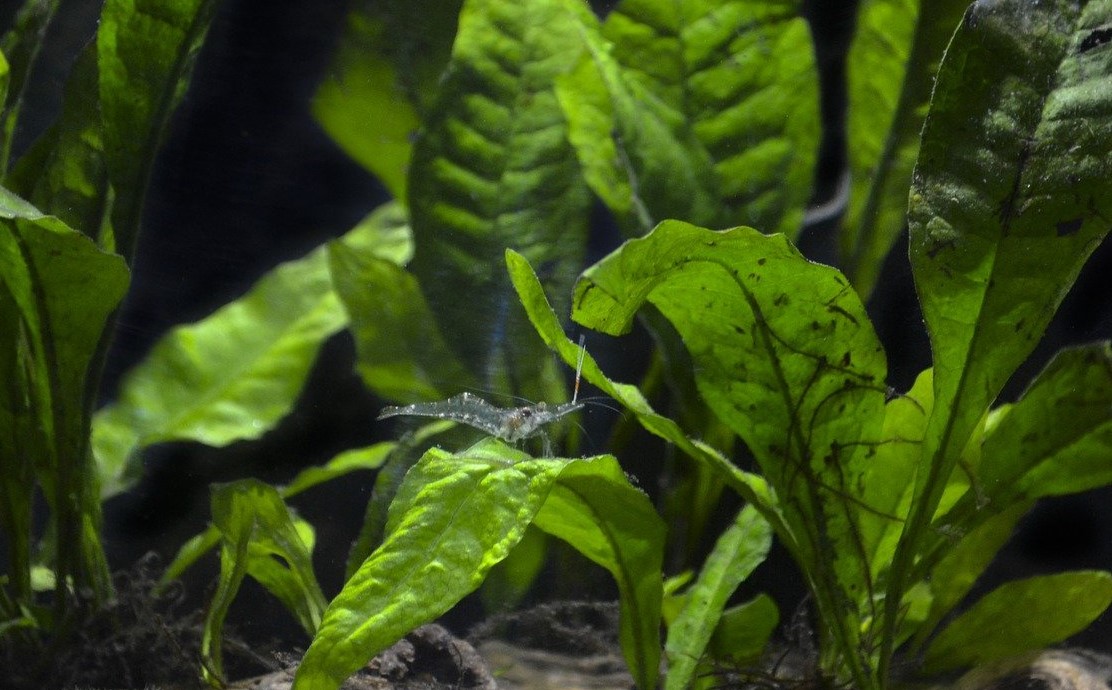
Shrimp on java fern
If you have large fish in your aquarium, they can knock java fern off its perch while the rhizomes are still growing and attaching to the substratum. Especially for the first few weeks, make sure that your fern is attached strongly to your chosen object with fishing line so that it can adhere properly.
A good idea to try if you find that your java fern is getting harassed by your fish is to give them a better option. Adding another plant such as hornwort can get the attention off the java fern. Not only is hornwort very hardy and able to handle herbivorous fish it can also be floated and aid in blocking light if the intensity is too high. Another option is to plant cabbage and lettuce in the substrate. Fish love fresh veg, and will much rather be eating that than your new java fern!
Conclusion
Java fern is a great plant for the overwhelming majority of freshwater aquariums. They can tolerate a range of conditions, and can be housed with all freshwater fish. As such they are perfect for both beginner tanks and for complex community setups.
They need stable conditions, so care should be taken that temperature, pH, and water hardness don’t fluctuate. Also needed are lower light conditions, so don’t have them near the top of the tank.
Not only is java fern easy to grow; it also looks amazing. With long leaves it will be a standout in your tank. There are multiple varieties available which can add even more to your tank.
Featured image credit: AquaticMag (Flickr) CC BY-SA 2.0

